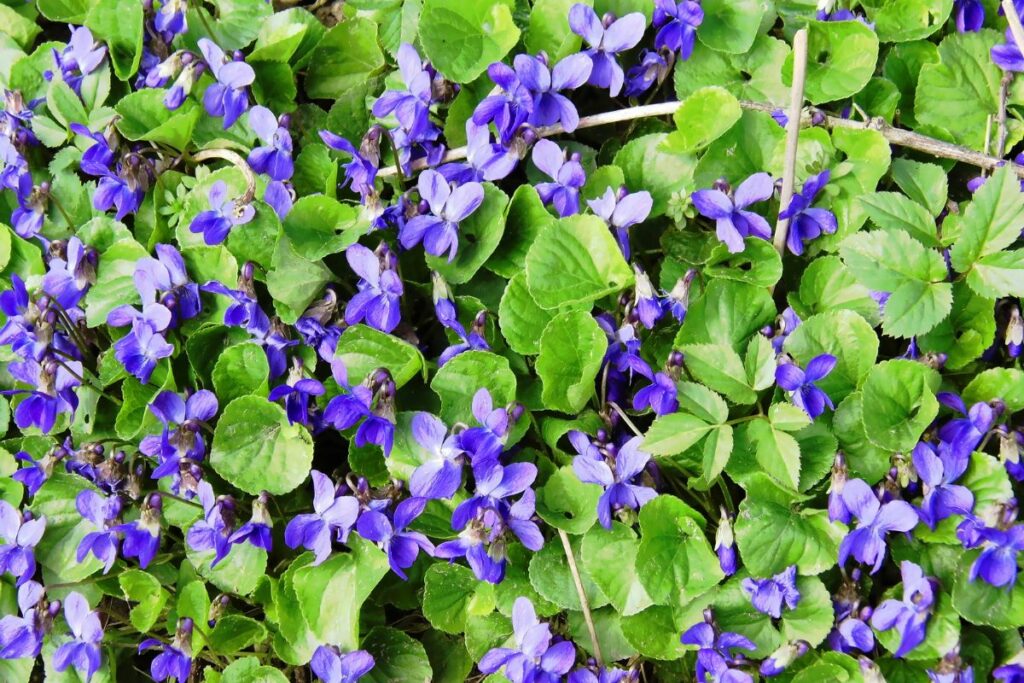Disclaimer: Our editors have used AI to create or enhance parts of this article and some images. All content has been fact-checked by our team to ensure accuracy.
Wild violets, with their delicate purple flowers, are commonly mistaken for mere weeds, yet they hold much more value than meets the eye. These plants not only enhance your garden’s aesthetic with their vibrant hues but also serve a practical purpose by inviting essential insects that benefit the ecosystem of your yard. Their presence means more than just a touch of color amid the green; they play a crucial role in the health and diversity of your garden.
Many gardeners strive for a picturesque lawn, and wild violets contribute to this with minimal effort on your part. By letting them grow, you can enjoy a lively and low-maintenance garden space. Beyond their visual appeal and ease of care, wild violets have additional qualities that might surprise you, further proving their worth in your outdoor sanctuary.
1. Essential Nourishment for Pollinators

Wild violets provide early-season sustenance to bees, butterflies, and other pollinating insects when few other blossoms are available.
Early-blooming species, such as wild violets, are invaluable in supporting newly awakened pollinators and are crucial for those considering establishing a pollinator-friendly garden.
While often labeled as “weeds”, these plants are indispensable in maintaining ecological balance, particularly for the caterpillar stage of various fritillary butterflies. This includes the esteemed Diana fritillary butterfly of Arkansas.
A diverse array of early-season “weeds,” including wild violets, dandelions, henbit, purple deadnettle, and chickweed, offer critical nourishment to these insects.
Advice for Lawn Care:
Avoid using herbicides while these plants are flowering, as it poses a significant risk to the crucial insects that feed on them.
If you aim for a tidier lawn appearance, opt to mow your garden before the flowering period or remove these plants when not in bloom to reduce interference with local pollinator populations.
2. Wild Violets: Low Effort, High Reward
Wild violets are an exemplary choice for gardeners seeking plants that require very little intervention. Among various flora that claim to be undemanding, wild violets genuinely exemplify the essence of self-reliance – they are about as independent as vegetation can get.
Self-Sustaining Attributes:
- Thriving in suboptimal soil conditions
- Flourishing with little to no supplemental watering or fertilization
- Expanding their presence through natural self-seeding
In areas where conventional grass may battle to take root, wild violets could be your perfect alternative. Especially for those contending with a lawn that refuses to flourish under tough conditions like drought or extreme heat, these plants can offer a verdant reprieve without straining your resources.
After a drought, wild violets have a remarkable ability to **revitalize quickly** following rainfall, ensuring that your garden remains vibrant with minimal effort on your part.
3. The Perks of Low-Maintenance Landscaping

Wildflowers such as wild violets are an excellent choice for a lush, low-upkeep yard. These vibrant, no-trim alternatives not only add color and charm but also liberate you from the routine of lawn mowing.
- Adaptability: Wild violets flourish in diverse lighting, preventing unsightly barren spots.
- Growth Patterns: They provide a verdant ground cover, remaining petite in shade and gaining height in sunlight.
By embracing these naturally occurring plants, you contribute to a microhabitat that improves soil quality and invites beneficial pollinators.
- Natural Allies: In addition to wild violets, consider white clover and creeping thyme for a robust, eco-friendly garden.
- Transition Time: Shifting from traditional grass may require patience, yet the ecological and personal advantages are long-lasting.
Switching to a wildflower lawn means weekends are no longer reserved for lawn care, and you get to enjoy a garden that takes care of itself and the environment.
4. Edible Ornamentals: A Hidden Food Source
Wild violets in your garden are more than just a visual treat. These versatile plants are part of the “edimentals” trend—ornamentals that are also edible. They not only beautify your space but also provide a bounty of free, nutritious food.
Leaves: Young violet leaves can be:
- Tossed into salads for a nutritional boost
- Cooked similarly to spinach
Flowers: The vibrant purple flowers are ideal for:
- Garnishing a variety of dishes
- Infusing vinegars and syrups, enhancing them with a unique flavor
Consider adding violets to homemade cookies for an aromatic twist. Besides their culinary uses, wild violets are also healthful. Rich in vitamins A and C, they support your well-being with their anti-inflammatory and antioxidant benefits.
It’s important to distinguish between edible wild violets and their non-edible relatives, such as the African violet, which is not suitable for consumption.
By allowing wild violets to prosper in your garden, you encourage an ecosystem that benefits pollinators and provides you with easily accessible edible plants. Enjoy the dual advantages of these plants’ beauty and their contribution to a nutritious diet.